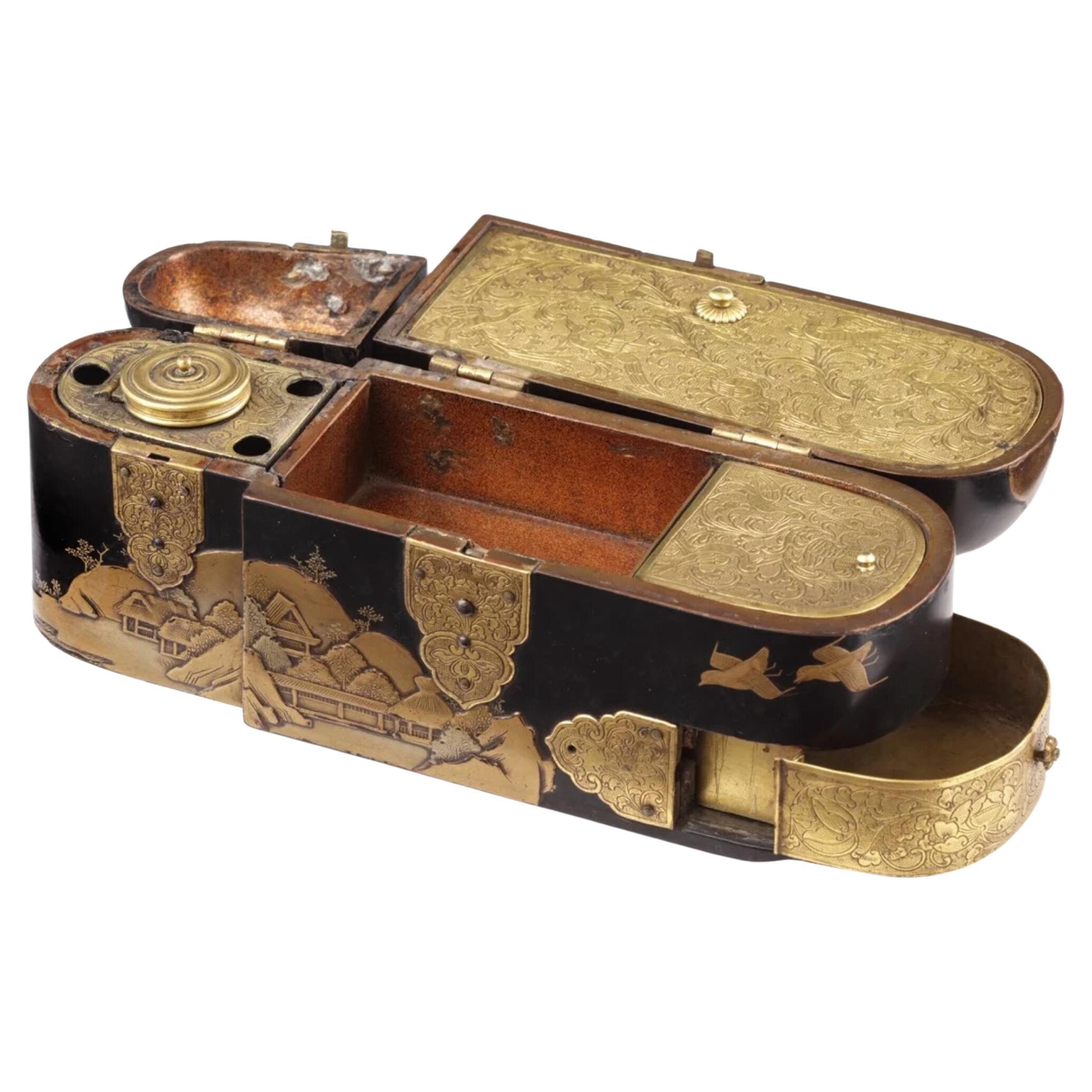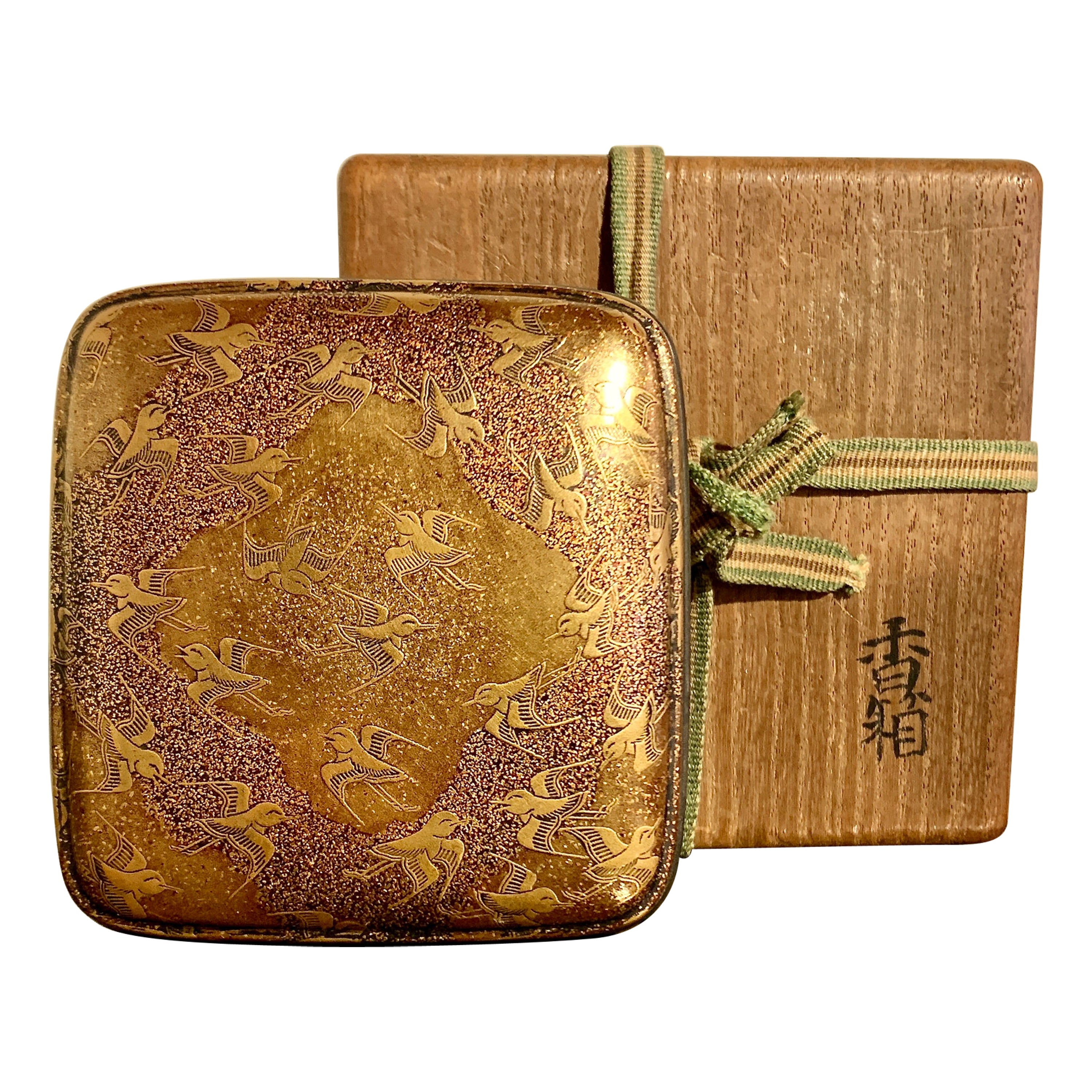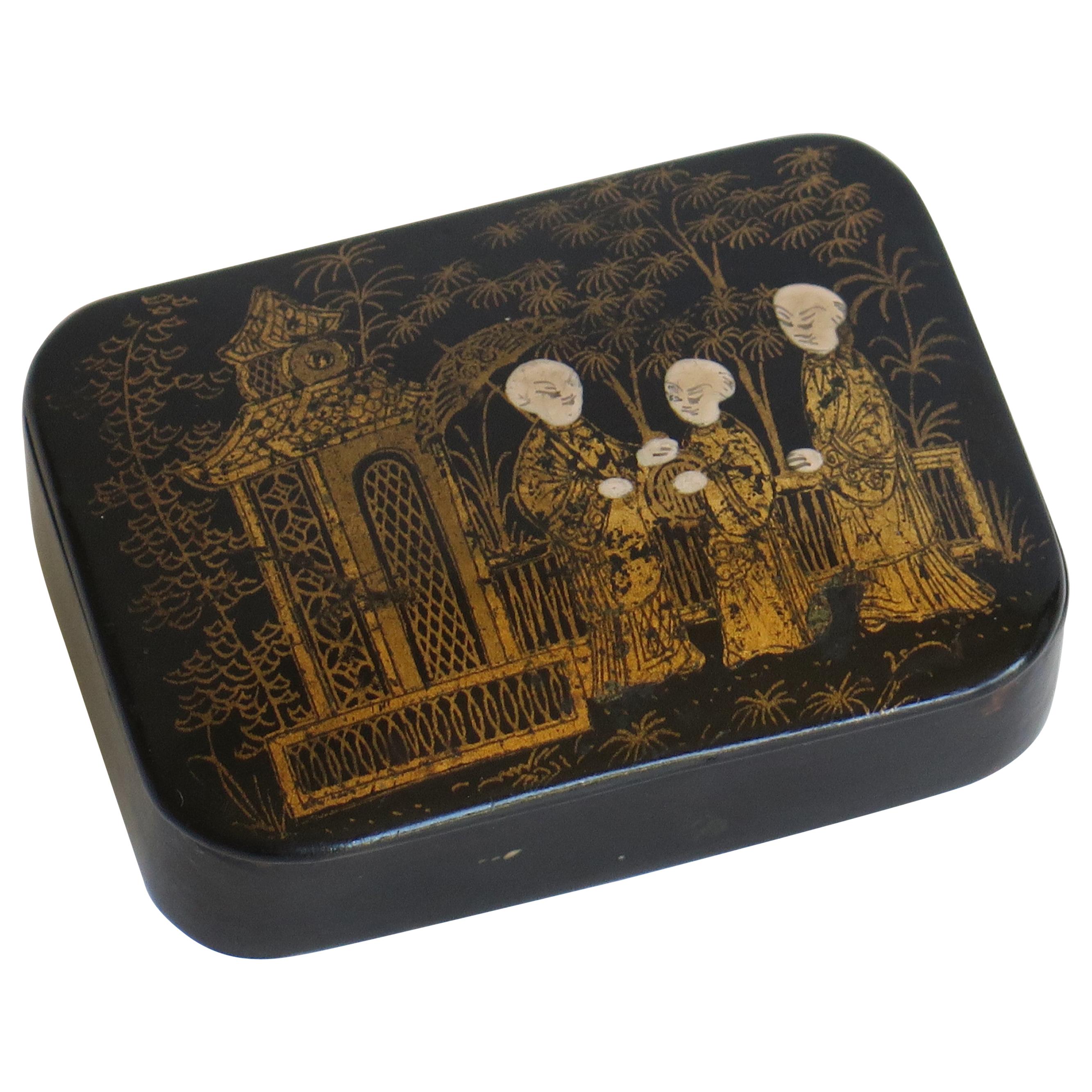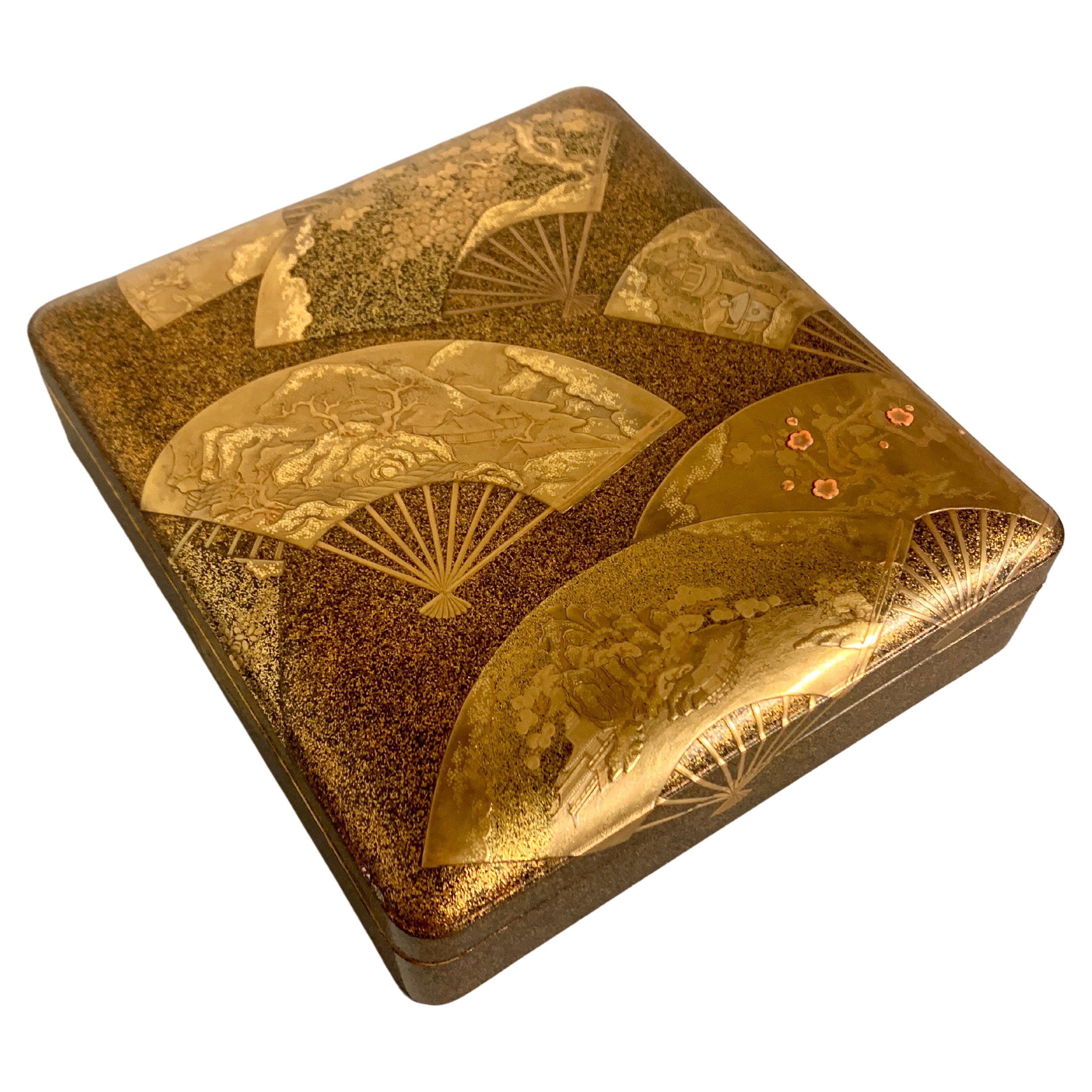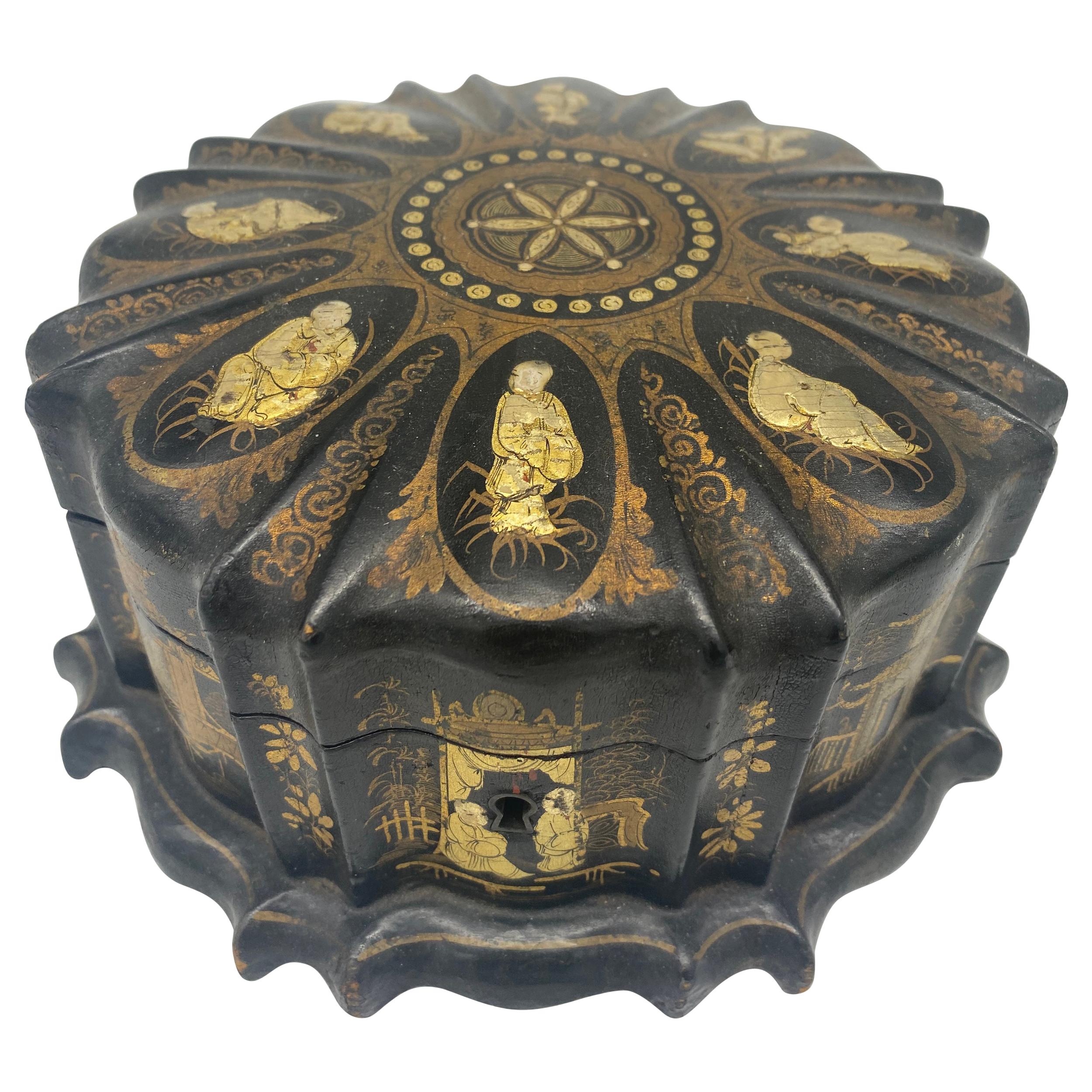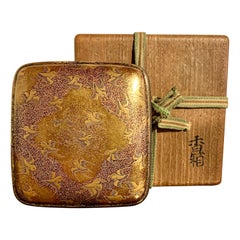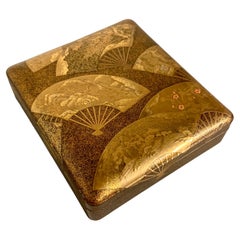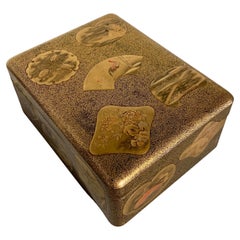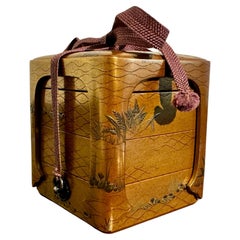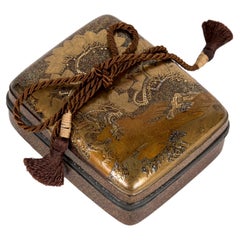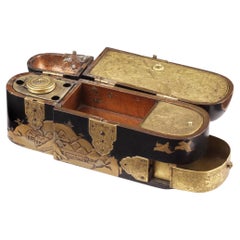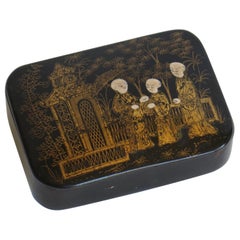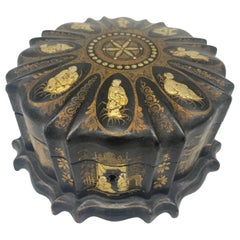Items Similar to Japanese Lacquer Box, Kogo, Tale of Genji, Edo Period, early 19th century, Japan
Want more images or videos?
Request additional images or videos from the seller
1 of 13
Japanese Lacquer Box, Kogo, Tale of Genji, Edo Period, early 19th century, Japan
$2,300
£1,745.19
€1,995.47
CA$3,212.48
A$3,571.84
CHF 1,865.02
MX$43,477.95
NOK 23,796.79
SEK 22,296.46
DKK 14,892.53
Shipping
Retrieving quote...The 1stDibs Promise:
Authenticity Guarantee,
Money-Back Guarantee,
24-Hour Cancellation
About the Item
A fine Japanese small lacquer box for precious incense, kogo, Edo period, mid 19th century, Japan.
The small box of gold lacquer and wonderfully decorated with a scene in raised takamaki-e lacquer from the Tales of Genji, Chapter 13: Akashi.
This scene portrays Prince Genji on his way to meet the Akashi Lady for the first time. After many machinations and pressure from the Akashi Lady's father, the former governor of Akashi convinces the Akashi Lady to receive Genji at her home. When Genji arrives, she refuses him entry, but allows him to hear her play the koto. Thus begins their short affair before Genji is recalled to the capital. The Akashi Lady will eventually give birth to Genji's daughter, the future empress.
Genji is portrayed on horseback, dressed in sumptuous robes and a princely kanmuri hat. His horse dressed in attractive bright red tack. Genji rides under a full moon through a coastal terrain of rocky outcrops and flowering plants, water gently lapping to one side. His ever present attendant walking behind.
The interior and underside decorated in nashiji (pear skin) lacquer. The interior of the lid also with an attractive spray of stylized lotus leaves and blossoms.
- Dimensions:Height: 2 in (5.08 cm)Width: 3 in (7.62 cm)Depth: 3 in (7.62 cm)
- Style:Edo (Of the Period)
- Materials and Techniques:
- Place of Origin:
- Period:
- Date of Manufacture:early 19th century
- Condition:Wear consistent with age and use. Minor losses. Minor fading. Overall good condition for age. One bottom corner with slight lacquer loss. One small chip to the interior of the box. The pewter heavily tarnished.
- Seller Location:Austin, TX
- Reference Number:1stDibs: LU894741013712
About the Seller
5.0
Platinum Seller
Premium sellers with a 4.7+ rating and 24-hour response times
Established in 2001
1stDibs seller since 2010
345 sales on 1stDibs
Typical response time: <1 hour
- ShippingRetrieving quote...Shipping from: Austin, TX
- Return Policy
Authenticity Guarantee
In the unlikely event there’s an issue with an item’s authenticity, contact us within 1 year for a full refund. DetailsMoney-Back Guarantee
If your item is not as described, is damaged in transit, or does not arrive, contact us within 7 days for a full refund. Details24-Hour Cancellation
You have a 24-hour grace period in which to reconsider your purchase, with no questions asked.Vetted Professional Sellers
Our world-class sellers must adhere to strict standards for service and quality, maintaining the integrity of our listings.Price-Match Guarantee
If you find that a seller listed the same item for a lower price elsewhere, we’ll match it.Trusted Global Delivery
Our best-in-class carrier network provides specialized shipping options worldwide, including custom delivery.More From This Seller
View AllJapanese Lacquer Incense Box, Kogo, Momoyama or Edo Period, 16th/17th Century
Located in Austin, TX
A wonderful Japanese lacquer incense box, kogo, with a design of plovers in flight, late Momoyama or early Edo Period, circa 1600, Japan.
The small box, called a kogo, was used to s...
Category
Antique Early 17th Century Japanese Edo Lacquer
Materials
Gold, Pewter
Japanese Maki-e Lacquer Document Box, Edo Period, early 19th Century, Japan
Located in Austin, TX
A spectacular Japanese maki-e lacquer lidded box, possibly a writing box, suzuribako, decorated with images of folding fans, ogi, Edo Period, earl...
Category
Antique Early 19th Century Japanese Edo Lacquer
Materials
Coral
Large Japanese Lacquer Document Box, Ryoshibako, Edo/Meiji period, Japan
Located in Austin, TX
A large and magnificently decorated Japanese lacquer document box, ryoshibako, signed Umeboshi/Baikyo, late Edo or early Meiji Period, mid 19th century, Japan.
The large document box, ryoshibako, of tall, rectangular shape with rounded corners, and fitted with an inrobuta (flush-fitting) cover with beveled edges. The exterior of this exquisite box is decorated all over with fifteen different raised reserves shaped as uchiwa (paddle) fans against a lush and intricate krikane ground imitating shagreen.
The uchiwa shaped reserves all of takamaki-e, and exquisitely painted with designs of animals, flowers, and landscapes in silver, gold, maki-e, hiramaki-e, and takamaki-e, with kirikane, nashiji, and polychrome embellishments, upon gold lacquer fudame grounds.
The interior of the lid is nothing short of spectacular, featuring a large design of a magnificent and beautifully detailed rooster and hen with chicks gathered around a lazy stream. Large stalks of chrysanthemum bloom behind them. All against an ethereal nashiji ground.
The cover of the box features five reserves:
1. Three minogame (turtles with long tails), symbolizing longevity
2. "Narihira Crossing the Sumida" from The Tales of Ise...
Category
Antique 1860s Japanese Meiji Lacquer
Materials
Softwood, Lacquer
Japanese Stacking Incense Box, Ju-Kobako, Meiji Period, Mid 19th century, Japan
Located in Austin, TX
An exquisite small Japanese maki-e lacquer stacking box for incense and accessories, ju-kobako, late Edo or early Meiji Period, mid 19th century, Japan.
Crafted in maki-e lacquer an...
Category
Antique Mid-19th Century Japanese Meiji Lacquer
Materials
Silver
Japanese Edo Period Igarashi School Long Lacquer Box, Tanzaku-Bako
Located in Austin, TX
A stunning Japanese Edo period lacquer tanzakubako, box for poem cards, late 18th-early 19th century, Edo Period, Japan.
Attributed to the Igarashi School, this box is masterfully ...
Category
Antique Early 19th Century Japanese Edo Lacquer
Materials
Mother-of-Pearl, Lacquer
Japanese Lacquer Smoking Box, Tabako Bon, Edo Period, 19th Century
Located in Austin, TX
A very fine Japanese maki-e lacquer decorated tabako bon, or smoking box, late Edo Period, mid-19th century, Japan.
The elegant smoking box of black lacquer decorated with a wonderful gold lacquer takamaki-e design of a gnarled and elegantly twisted plum tree with branches in full bloom. A border of golden cranes in flight to the top.
The smoking box, called a tabako bon, is comprised of an open section at the top with inset with two cylindrical metal canisters...
Category
Antique Mid-19th Century Japanese Edo Lacquer
Materials
Lacquer
You May Also Like
Japanese landscape pine kobako box Edo period 18th century
Located in PARIS, FR
Rectangular black and gold lacquer kobako box decorated with pine trees in a mountain landscape in takamaki-e, kirigane and hiramaki-e lacquer. Background in nashi-ji lacquer. Surmou...
Category
Antique 18th Century Japanese Lacquer
Materials
Gold
Rare 17th Century Japanese Export Lacquer Medical Instrument Box
Located in Amsterdam, NL
A rare Japanese export lacquer medical instrument box
Edo-period, 1650-1700
L. 19 x W. 6 x H. 8.5 cm
This unconventionally shaped lacquer b...
Category
Antique 17th Century Japanese Edo Lacquer
Materials
Gold
Japanese Laquered Box with Hinged Lid hand painted, 19th Century Meiji Period
Located in Lincoln, Lincolnshire
This is a good papier mâché, rectangular shaped black lacquered lidded box, hand enamelled and gilded, made in Japan during the 19th century, early Meiji period.
This rectangular shaped papier mâché box has a well fitting hinged lid, with the box base and lid slightly domed. The box was probably originally made as a pocket box but could easily sit on a desk or dressing table as required.
This is a very decorative box with finely hand painted scenes of three people, one holding a parasol, in a garden setting, with a pagoda type building, large gate...
Category
Antique 19th Century Japanese Meiji Lacquer
Materials
Paper
19th Century Chinese Lacquer Jewelry Box
Located in Brea, CA
19th century Qing Dynasty Chinese lacquer jewelry box detailed with various genre scenes in gold detail. Pink silk lining, can be locked, does not ...
Category
Antique 19th Century Chinese Qing Lacquer
Materials
Lacquer
A Maki-e Lacquer Tebako Box Embellished With Gold Decorations
Located in Milano, IT
Tebako lacquer maki-e box embellished with gold decorations depicting a Buddhist temple surrounded by majestic Matsu pines. The interior and base are finished in nashiji lacquer. The...
Category
Antique 19th Century Japanese Lacquer
Materials
Lacquer
$2,740 Sale Price
20% Off
Meiji Period Lacquer Box
Located in Chapel Hill, NC
Meiji period small lacquer box with hinged lid, Japanese. Finely decorated - bits of abalone inlay add sparks in several areas. The recessed circle...
Category
Antique Late 19th Century Japanese Meiji Decorative Boxes
Materials
Lacquer
$236 Sale Price
20% Off
More Ways To Browse
Japanese Ceramics Edo Period Or Earlier
Red Lacquer Furniture
Edo Period Japanese Art
Antique Lacquer Box
Antique Lacquer Boxes
Red Lacquer Box
Lotus Leaves
Japanese Lacquer Boxes
Edo Period Gold
Pear Wood Furniture
Antique Hat Boxes
Antique Pewter Box
Japanese Red Lacquer Box
Hat Box Wood
Incense Box
Antique Horse Tack
Antique Wood Hat Box
Japanese Incense Box

